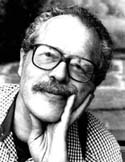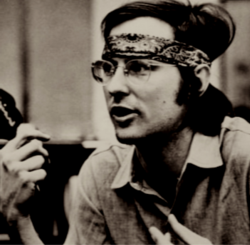Related Research Articles

Fluxus was an international, interdisciplinary community of artists, composers, designers, and poets during the 1960s and 1970s who engaged in experimental art performances which emphasized the artistic process over the finished product. Fluxus is known for experimental contributions to different artistic media and disciplines and for generating new art forms. These art forms include intermedia, a term coined by Fluxus artist Dick Higgins; conceptual art, first developed by Henry Flynt, an artist contentiously associated with Fluxus; and video art, first pioneered by Nam June Paik and Wolf Vostell. Dutch gallerist and art critic Harry Ruhé describes Fluxus as "the most radical and experimental art movement of the sixties".

Nam June Paik was a South Korean artist. He worked with a variety of media and is considered to be the founder of video art. He is credited with the first use (1974) of the term "electronic super highway" to describe the future of telecommunications.

Postmodern art is a body of art movements that sought to contradict some aspects of modernism or some aspects that emerged or developed in its aftermath. In general, movements such as intermedia, installation art, conceptual art and multimedia, particularly involving video are described as postmodern.

Dick Higgins was an American artist, composer, art theorist, poet, publisher, printmaker, and a co-founder of the Fluxus international artistic movement. Inspired by John Cage, Higgins was an early pioneer of electronic correspondence. Higgins coined the word intermedia to describe his artistic activities, defining it in a 1965 essay by the same name, published in the first number of the Something Else Newsletter. His most notable audio contributions include Danger Music scores and the Intermedia concept to describe the ineffable inter-disciplinary activities that became prevalent in the 1960s.
Madeline Charlotte Moorman was an American cellist, performance artist, and advocate for avant-garde music. Referred to as the "Jeanne d'Arc of new music", she was the founder of the Annual Avant Garde Festival of New York and a frequent collaborator with Korean American artist Nam June Paik.

Henry Flynt is an American philosopher, musician, writer, activist, and artist connected to the 1960s New York avant-garde. He coined the term "concept art" in the early 1960s, during which time he was associated with figures in the Fluxus scene. He later received attention for his anti-art demonstrations against New York cultural institutions in 1963 and 1964.
The New York School was an informal group of American poets, painters, dancers, and musicians active in the 1950s and 1960s in New York City. They often drew inspiration from surrealism and the contemporary avant-garde art movements, in particular action painting, abstract expressionism, jazz, improvisational theater, experimental music, and the interaction of friends in the New York City art world's vanguard circle.

George Brecht, born George Ellis MacDiarmid, was an American conceptual artist and avant-garde composer, as well as a professional chemist who worked as a consultant for companies including Pfizer, Johnson & Johnson, and Mobil Oil. He was a key member of, and influence on, Fluxus, the international group of avant-garde artists centred on George Maciunas, having been involved with the group from the first performances in Wiesbaden 1962 until Maciunas' death in 1978.

Joseph Hunter Byrd Jr. is an American composer, musician and academic. After first becoming known as an experimental composer in New York City and Los Angeles in the early and mid-1960s, he became the leader of The United States of America, an innovative but short-lived band that integrated electronic sound and radical political ideas into rock music. In 1968 he recorded the album The American Metaphysical Circus, credited to Joe Byrd and the Field Hippies. After working as a record producer, arranger, and soundtrack composer, he became a university teacher in music history and theory.
The mid-20th-century art movement Fluxus had a strong association with Rutgers University.
Takehisa Kosugi was a Japanese composer, violinist and artist associated with the Fluxus movement.

The Block Museum of Art is a free public art museum located on the campus of Northwestern University in Evanston, Illinois. The Block Museum was established in 1980 when Chicago art collectors Mary and Leigh B. Block donated funds to Northwestern University for the construction of an art exhibition venue. In recognition of their gift, the university named the changing exhibition space the Mary and Leigh Block Gallery. The original conception of the museum was modeled on the German kunsthalle tradition, with no permanent collection, and a series of changing temporary exhibits. However, the Block Museum soon began to acquire a permanent collection as the university transferred many of its art pieces to the museum. In recognition of its growing collection and its expanding programming, the Gallery became the American Alliance of Museums accredited Mary and Leigh Block Museum of Art in 1998. The Block embarked on a major reconstruction project in 1999 and reopened in a new facility in September 2000.
Sandra Binion is a Swedish-American artist based in Chicago whose artistic practice includes fine-art exhibitions, multimedia installations involving, and performance art. Her work has been performed and exhibited at museums, galleries, theaters, and festivals in the US, Europe, and Japan. Some of the venues that have featured her work include the Evanston Art Center, Link's Hall, Kunstraum (Stuttgart), The Goodman Theatre, and Los Angeles Institute of Contemporary Art.
Experimental music is a general label for any music or music genre that pushes existing boundaries and genre definitions. Experimental compositional practice is defined broadly by exploratory sensibilities radically opposed to, and questioning of, institutionalized compositional, performing, and aesthetic conventions in music. Elements of experimental music include indeterminacy, in which the composer introduces the elements of chance or unpredictability with regard to either the composition or its performance. Artists may approach a hybrid of disparate styles or incorporate unorthodox and unique elements.

Terry Jennings was a Fluxus-related California-born American minimalist composer and woodwind performer.
Source: Music of the Avant-Garde – also known and hereafter referred to as Source Magazine – was an independent, not-for-profit musical and artistic magazine published between 1967 and 1973 by teachers and students of the University of California, Davis, California. It emerged from the flourishing Californian musical experimentalism of the late 1950s-early 1960s, at UC-Davis and Mills College. The 11 issues document new music practices of the period like indeterminacy, performance, graphic scores, electronic music and intermedia arts.

Originale, musical theatre with Kontakte, is a music theatre work by the German composer Karlheinz Stockhausen, written in collaboration with the artist Mary Bauermeister. It was first performed in 1961 in Cologne, and is given the work number 12⅔ in Stockhausen's catalogue of works.
Charlie Morrow is an American sound artist, composer, conceptualist, and performer. His creative projects have included chanting and healing works, museum and gallery installations, large-scale festival events, radio and TV broadcasts, film soundtracks, commercial sound design, and advertising jingles.
Jim McWilliams is an American artist and graphic designer who was active as an avant-garde performer and composer during the 1960s and 1970s.
Nye Ffarrabas, is an American artist and poet known for her contributions to the first generation of Fluxus. She participated in Judson Gallery shows at Judson Memorial Church in 1966-1968.
References
- ↑ The EAI Archives Online. "Annual Avant Garde Festivals".
- 1 2 3 4 5 6 7 8 9 10 11 12 13 14 15 "Fondazione Bonotto - Fluxus Collection - Annual Avant Garde festivals: 1963-1980" . Retrieved November 27, 2013.
- ↑ Nair, Nandini. "The Second New York Avant Garde Festival". OthergroundNY.com. Archived from the original on 2013-12-03. Retrieved 2013-11-27.
- 1 2 "Electronic Arts Intermix: 4th & 7th Annual New York Avant Garde Festivals" . Retrieved November 27, 2013.